Майолика ренессанса. Giorgio Andreoli da Gubbio-(1465-1553)
Итальянская майолика.Часть 2. Giorgio Andreoli da Gubbio-(1465-1553)

В 16 веке в Италии керамику производили более ста городов, они выработали свои особые стили и техники.
Мастера того времени дали развитие для керамики на много столетий вперед, в стиле ренессанс и нео-ренессанс ее делали вплоть до двадцатого века.

Один из выдающихся мастеров- Джорджио Андреоли, он был рожден в Интре, с возраста около тридцати лет жил в в Губбио.
Его мастерские изготавливали дорогую люстровую майолику, в том числе редкую рубиново-красную.

1520 (circa)
В его росписях много гротескных орнаментов и фигур, религиозных и мифологических сюжетов, характерных для ренессаса: Три грации, суд Париса, Немейский лев, гидра и т.п.
Его работ много в крупных музеях: Британском, Метрополитен, Виктории и Альберта, а также в региональных музеях Италии.
-------------Giorgio Andreoli da Gubbio-(1465-1553)------------
==========================================================

Maestro Giorgio Andreoli
Giorgio Andreoli of Gubbio
Broad-rimmed bowl with palmette and cornucopia border; in the center, shield of arms of the Saracinelli of Orvieto
Giorgio Andreoli, called Giorgio da Gubbio,
Maestro Giorgio- Italian potter,ceramicist (b. ca. 1465, Intra, d. 1553, Gubbio)
b. about 1465 near Lake Maggiore, Italy, d. about 1553
-------------------орнаменты и гротеск------------
======================================================

Plate with grotesques and trophies surrounding the coat of arms of Francesco Maria I Della Rovere
Circular rings on reverse and dark purple brown patch due to misfiring
1522
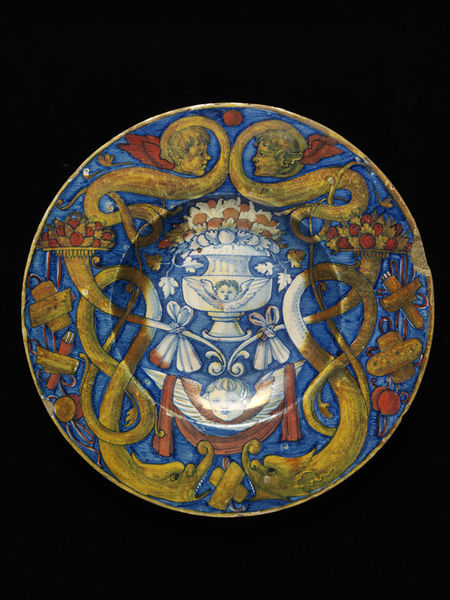
Plate decorated with painted grotesque design incorporating a vase and a seraph in the centre. The border has a pair of human headed serpents and a pair of dolphin headed serpents. The background is filled-in with blue enamel in distinctive parallel horizontal brush strokes. On the back, painted in blue, a halberd and the date 1515.

1515-1520 (circa)

In the well an ogee quatrefoil with foliate scrollwork and a cross, and the letters "F", "G" and "KO", with a hand in the centre, probably a monastic emblem.
1518

in the centre, Cupid, winged, standing bound and blindfolded. On the rim, grotesques incorporating four roundels with musical instruments, two of them carry an owner's mark, "S"
1524

On the rim grotesques, monsters, arms and armour, cornucopias and tablets inscribed "1524" and "florid.virtus".


Plate
Gubbio
c. 1530 - 35
--------------------Портреты-----------
=========================================

shield of arms of the Saracinelli of Orvieto
Artist: Workshop of Maestro Giorgio Andreoli of Gubbio
Title: Broad-rimmed bowl with shield of arms of the Saracinelli of Orvieto
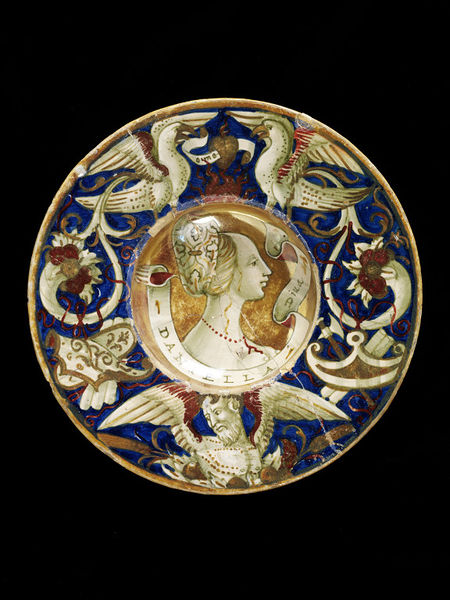
Plate depicting a female bust in the centre, in grisaille, and the name DANIELLA in a scroll. Painted in blue, olive green and white highlights, and with red and gold lustre. The background is filled in with blue. The dish is dated 1530 in blue, under the lustre on the shield on 22 past. On the back, the mark MoG0 and the date 1531 and five scrolls.
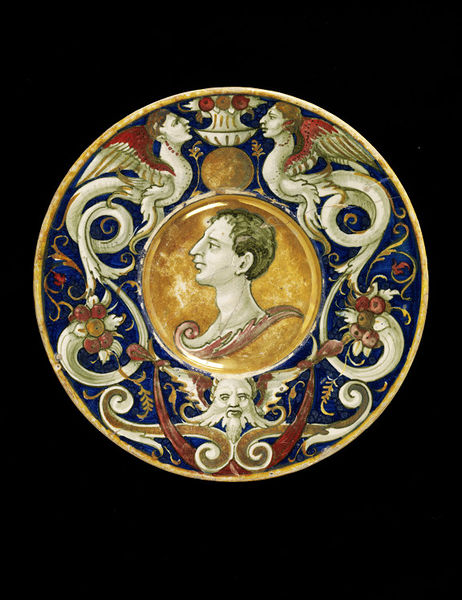
1531 (dated)

In the centre a profile on a lustre-dotted blue ground, with a scroll "IPOLITA DIVA". On the rim grotesques on a pale lustre ground, and a tablet with the date 1530 overpainted 1531 in lustre.

a three-quarter view portrait bust of "AVRA BELLA", wearing an elaborate head-dress. On the reverse foliate scrolls in red and golden lustre.
1530
--------------------------------
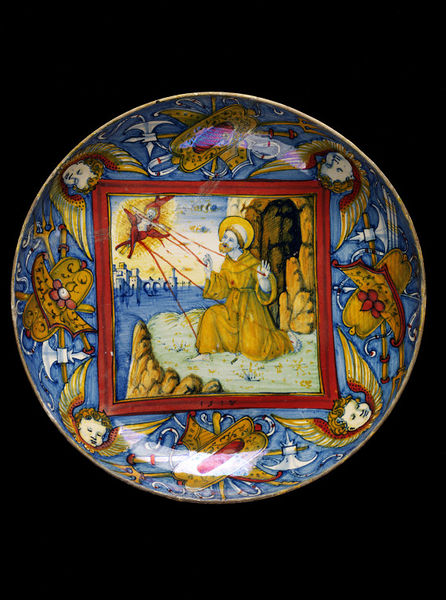
Dish on low foot depicting St. Francis receiving the stigmata, made in the workshop of Maestro Giorgio Andreoli, Gubbio, dated 1518 and 1519, tin-glazed earthenware with lustre decoration
1518

Piatto di Maestro Giorgio Andreoli. Gubbio 1525 c.
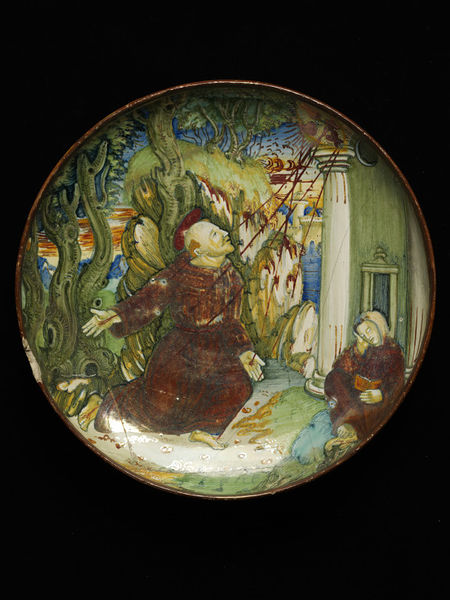
Dish on low foot, with St. Francis receiving the Stigmata. The date and Maestro Giorgio workshop mark are painted in red lustre.
1532
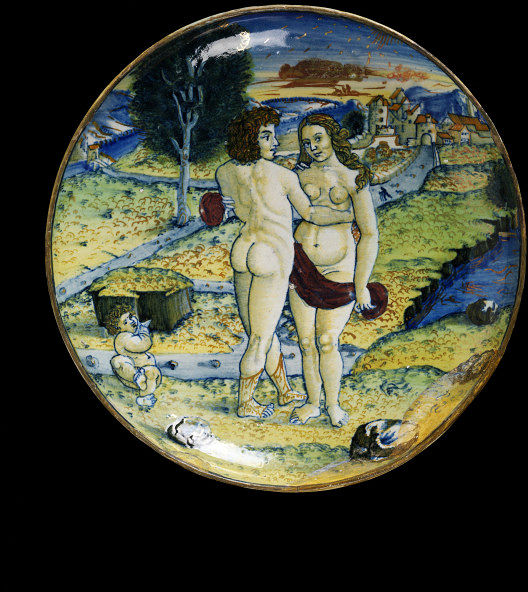
Small dish on foot-rim, depicting a man and woman in a landscape. Painted in blue, green, olive green and yellow and with red and gold lustre.

Small dish depicting three tritons, one of them with a Sea-nymph on his back. Painted in blue, green, yellow and orange and with gold and red lustre. Relief lines around the rim on the front, and turning-marks on the back. Date and mark on the back in gold lustre "1525 .
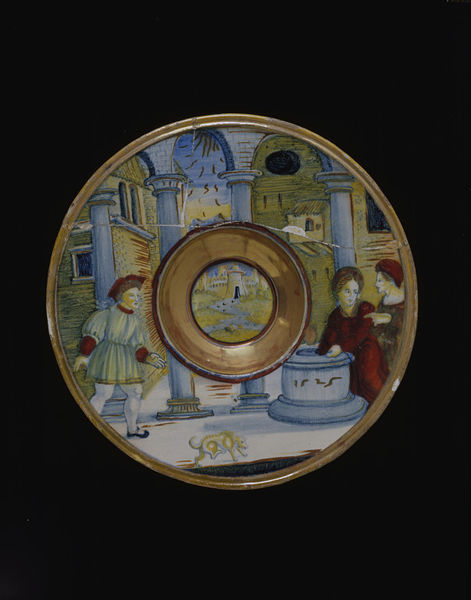
Small dish depicting two women at a well and a man approaching from the left. Painted in blue, green, yellow and ochre and with gold and red lustre. The date on the well-head is painted in blue and traced over in gold lustre.
1525
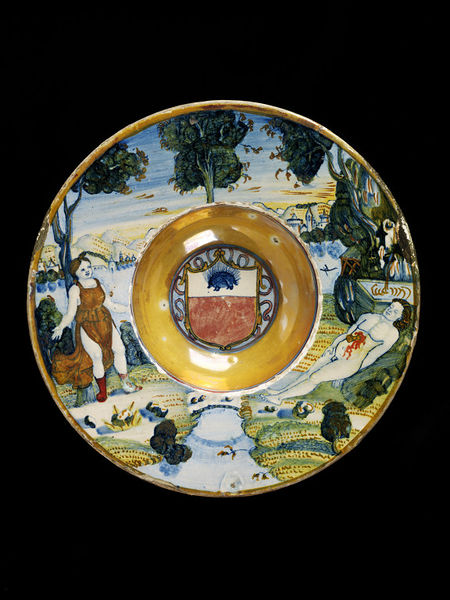
Plate- tin glazed earthenware painted in colours. The blue of a dark blackish tone. In the middle, in a medallion, a ribboned shield of arms. On the rim, the subject of the death of Pyramus; Thisbe approaches dismayed from the left to find him lying stabbed with a dagger beside a fountain. In the distance a river with a lake and mountains. On the back the signature: 1522 M° G°
--------------------------------

Mastro Giorgio Andreoli
Piatto, 1528 A capo di una fiorentissima bottega dal carattere quasi imprenditoriale, Mastro Giorgio da Gubbio ha reso universalmente nota la produzione ceramica eugubina del Rinascimento grazie all’utilizzo della tecnica del suo lustro “rosso rubino”.
Piatto raffigurante l'infanzia di Bacco. Maiolica, Gubbio, 1528

Gubbio, workshop of Maestro Giorgio Andreoli
Plate with a Love Argument
1522
tin-glazed earthenware with luster
Metropolitan Museum of Art

A Gubbio, nel XVI sec., opera Mastro Giorgio Andreoli, celebre per aver raggiunto risultati ineguagliati nella tecnica del lustro facendo la sua fortuna e differenziandolo, dal ‘500 ad oggi, da tutti gli altri artisti.
---------------------------------
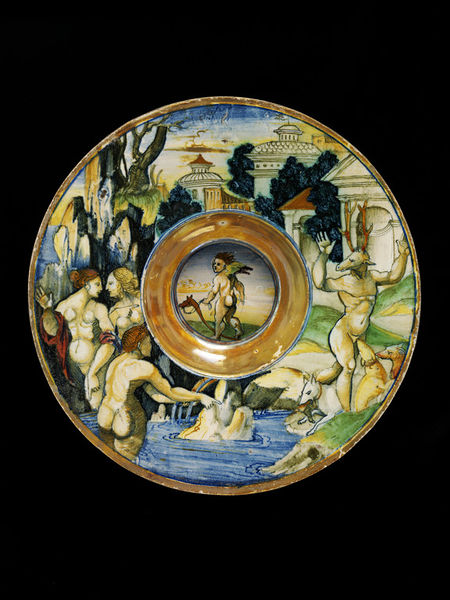
Dish with deep well, depicting Diana & Actaeon and in the centre a cupid riding a hobby horse. Painted in blue, black, green, brownish orange, yellow with white highlights and gold and red lustre. The rim has been slightly reduced to make it smooth again. On the back four leaf-scrolls and one circle around the rim, painted in gold lustre.
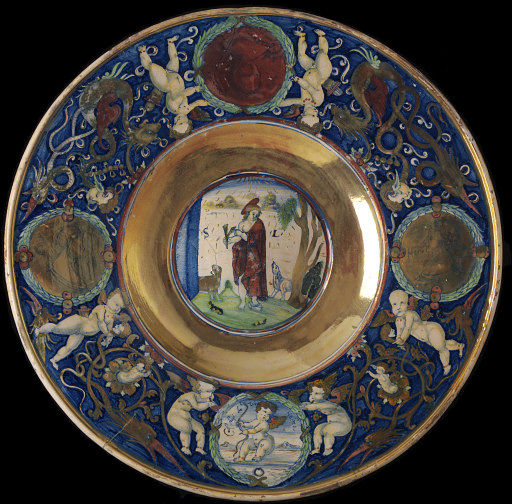
Large dish with St. Lazarus surrounded by a wide border of grotesque ornament, putti and four medallions. A firing crack, and bad staining on the back, also caused during firing. Painted with blue, green and yellow and with gold lustre.
---------------------------------------

Flat plate, painted by Maestro Giorgio, Gubbio or Urbino, dated 1537, tin-glazed earthenware
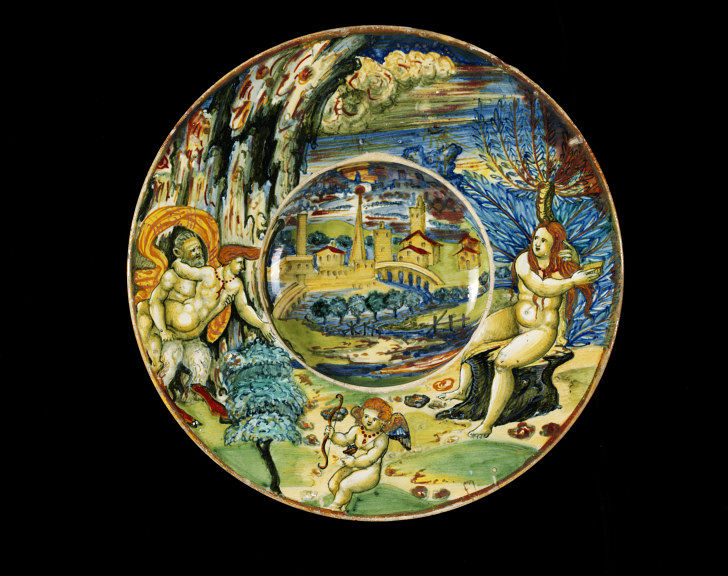
Dish with deep well depicting scene with mythological figures, probably from Ovid's 'Metamorphoses'
1535
---------------------------

1528 (dated)
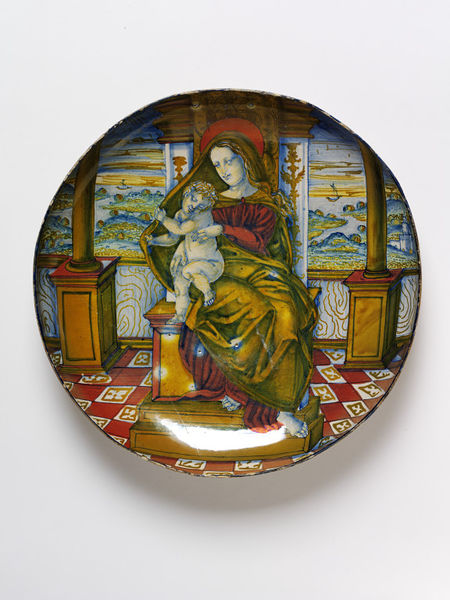
Plate bearing a depiction of the Virgin and Child.
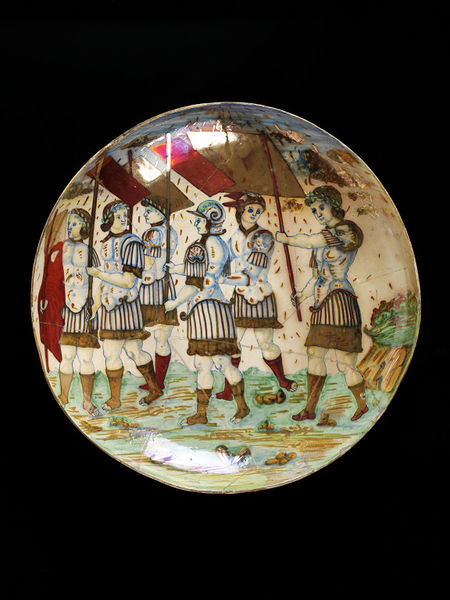
Dish on low foot, depicting six soldiers in Roman armour carrying banners. Painted in blue, green and yellow and with red and gold lustre. The back painted in red lustre, 2 sets of concentric rings with oblique gadroons in between, in the middle the maker's mark and date "MoGo. 1520".
--------------------------------

1525
Workshop of Maestro Giorgio Andreoli
n the well, a seated woman in a landscape. On the rim a townscape, to the left a satyr with a spear, to the right a satyr grabbing a woman.

Workshop of Maestro Giorgio Andreoli
After Marcantonio
1525
Painted decoration with yellowish and reddish lustre, three men in academic dress in landscape. Figures after an engraving by Marcantonio Raimondi.

The scene is based on the Judgement of Paris. On the rim Venus, Juno and Minerva and a reclining male figure (Paris). Male figure taken from an engraving by Marcantonio Raimondi

Painted decoration on front with golden and reddish lustre. On the rim, a landscape, two soldiers in Phrygian caps and a man about to throw a rock at them. Figures from an engraving by Marco da Ravenna after Raphael or Giulio Romano. I

Painted decoration and golden and reddish lustre, with a horseman with a standard riding through a landscape. Iconography from a series of Roman heroes by Marcantonio Raimondi.
1525

Painted decoration with golden and red lustre, reclining river god holding a rudder and palm branch. Figure after an engraving by Marcantonio Raimondi after Raphael's Judgement of Paris.
1524

1520 (circa)
Workshop of Maestro Giorgio Andreoli
Description
Shallow dish on low foot, earthenware covered front and back with a presumed tin-glaze. On the front painted decoration lustred in red, golden-brown and brown. In the foreground Hercules fighting the Nemean lion.
--------------------------------

Plate with Cupid and Minerva
Workshop of Maestro Giorgio Andreoli of Gubbio (c. 1465/1470 - 1555)
Italian
Painting attributed to the Painter of the Three Graces, Italian, active in Gubbio, c. 1525

Flat Plate with a Battle Scene
Workshop of Maestro Giorgio Andreoli of Gubbio (c. 1465/1475 - 1555)
Italian

Dish Depicting Saint Margaret
Workshop of Maestro Giorgio Andreoli Gubbio
1527

Clio riding a swan
Artist: probably the Workshop of Maestro Giorgio Andreoli of Gubbio
-----------------------

Gubbio, maestro giorgio, piatto con ercole e l'idra da antonio pollaiolo, 1520 ca
---------------------------

Dish
1525-30
Lustred tin-glazed earthenware, diameter 25 cm
Private collection
-------------------Три грации---------------
==============================================
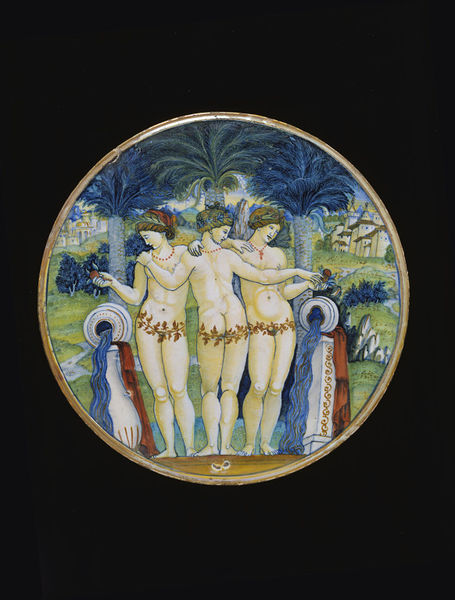
Три грации
Maestro Giorgio (workshop of, maker)
Avelli, Francesco Xanto (probably, painter)
There was a version of the Roman copy in Siena, in the
library that Cardinal Piccolomini built alongside the cathedral.

Maestro giorgio da gubbio, piatto con le tre grazie, 1535
----------------------------------

Castel Durante 1528 Painted by Giorgio Andreoli - Aurora (Lehman Collection)
---------------Школа-the workshop of Maestro Giorgio---------
===========================================================
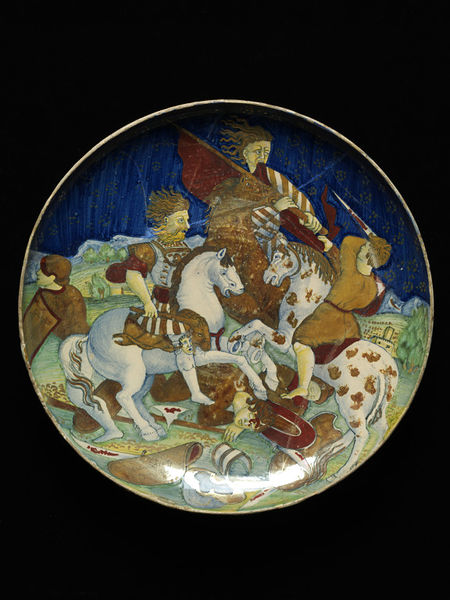
1522
Dish on a low foot depicting a battle scene with three mounted warriors and two footsoldiers. On the back in gold lustre the date and monogram M G
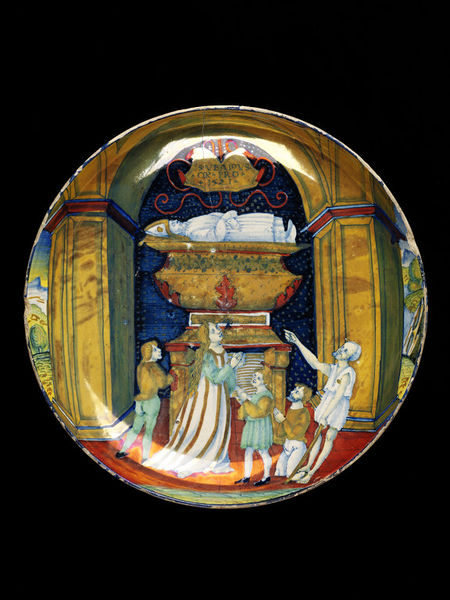
Ubaldus (1085-1160) is the patron saint of Gubbio; his day, 15th of May, is still celebrated today in the town with the Festa dei Ceri, one of the oldest religious festivals in Italy. In the Renaissance Ubaldus was widely venerated in the Gubbio region.
1521-22
-----------------Разное-------------
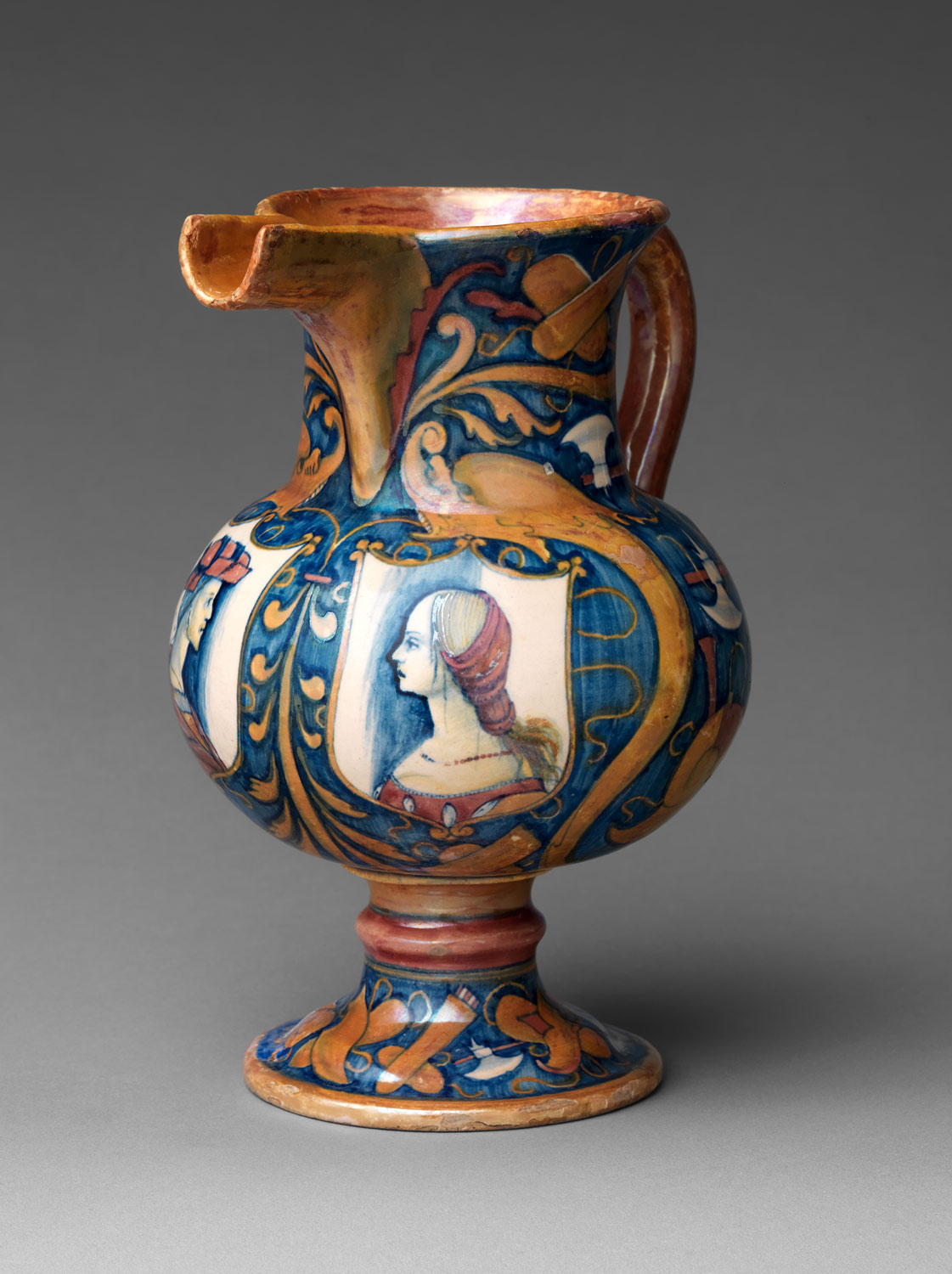
Ewer with profile busts of a man and a woman, ca. 1520
Possibly workshop of Maestro Giorgio Andreoli (Italian, ca. 1465-1553)
Tin-glazed earthenware (maiolica), with luster
The Metropolitan Museum of Art
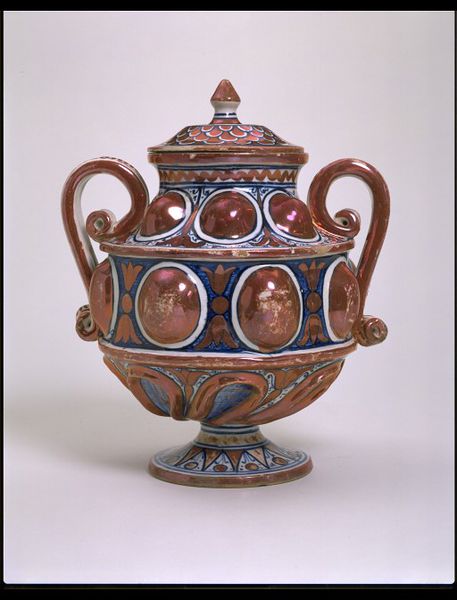
Vase and cover with two handles, tin-glazed earthenware with lustre decoration in brown, blue and white.
1500-1510 (made)
-------------------Алтарь----------------

Giorgio Andreoli: Altar mit Schutzmantelmadonna; aus der Kirche San Domenico, Gubbio, 1511
Liebieghaus, Frankfurt am Main


----------Painted by Francesco Xanto Avelli------------------
===========================================================

Lustred by Maestro Giorgio Andreoli (workshop of; probably)
Painted by Francesco Xanto Avelli
Painted decoration with red and golden lustre, to the right Mars in a winged helmet, left Venus reclining hugging a child (Cupid?), above a winged Cupid with a basket of fruit. Cupid is after Marcantonio after Raphael, Venus is after Marcantonio (Modi) after Giulio Romano and Mars is probably after Marcantonio after Francia.
1532

a woman on a large inflatable ball leaning on a stick, to the left a figure in armour helps another who has fallen and dropped a sceptre; female figure is after Marcantonio after Bandinelli, horseman and standing figure after Marcantonio after Raphael, fallen man after Marcantonio after Giulio Romano.
1534

Painted decoration on the front with red and gold lustre, in the centre a she-wolf suckling Romulus and Remus, on the right a standing river god with a river issuing from a vase on his shoulder, on the left a man apparently carrying the infants to be exposed. Figure to the left from an engraving by Marcantonio Raimondi. River god after Caraglio after Raphael.
1533

Lustred by Maestro Giorgio Andreoli (?)
Painted by Painter of the Apollo Basin (probably)
Front is painted with an angel driving Adam and Eve from the Garden of Eden. Lustred in golden and ruby lustre. Reverse is painted with seven rough scrolls in ruby lustre. Figure of the angel is after Marcantonio Raimondi after Raphael, Eve is after Marco da Ravenna(?) and Adam is after Marcantonio after Michelangelo(?).
1531 (probably)

Dish
1525
Tin-glazed earthenware, diameter 45 cm
Wallace Collection, London

Dish
Women Bathing
Attributed to Francesco Xanto Avelli da Rovigo (c. 1486 - c. 1542), (central scene)
Probably Francesco Urbini, (border)
Workshop of Maestro Giorgio Andreoli
Gubbio, Italy
6 April 1525
Tin-glazed earthenware, painted and lustred
Про Francesco Xanto Avelli будет отдельный пост, как и про майолику Урбино второй половины 16 века.
НАЧАЛО:
==============================================




Итальянская майолика 16 века. Nicola da Urbino-ТУТ
-------------------------------
http://en.wikipedia.org/wiki/Giorgio_Andreoli
Еще очень много здесь:
1-MORE-HERE-ТУТ
2-MORE-HERE-ТУТ
3-MORE-HERE-ТУТ
----------------------------
Giorgio Andreoli, named also Mastro Giorgio Andreoli or Mastro Giorgio, was born between 1465 and 1470 in Intra, on the Lake Maggiore, and died in Gubbio, where he spent most of his life, in 1555. He is considered to be the most important potter of the Italian Renaissance. He is famous as inventor of a particular kind of lusterware (lustro).
In 1498 he became a citizen of Gubbio and in 1518 invented his remarkable lustre, the chief characteristics of which are its beautiful gold and carmine colors. Good examples of his majolica may be found in the local museums of Gubbio, Urbino, Arezzo, and elsewhere in Italy, and also in the principal museums of decorative art in Europe, such as Berlin, Vienna, Paris, and South Kensington.
Not all works fired with his lustre were designed by him, for potters of the neighboring cities brought their work to him to be fired. He was assisted in his work by his brothers Salimbene and Giovanni, and after his death it was continued by his son Vincenzo.
-----------------------------------
http://www.flickr.com/search/?w=all&q=ANDREOLI%2C+Giorgio&m=text
http://www.google.ru/search?q=ANDREOLI,+Giorgio--Gubbio&oe=utf-8&rls=org.mozilla:ru:official&client=firefox&um=1&ie=UTF-
8&tbm=isch&source=og&sa=N&hl=ru&tab=wi&biw=1575&bih=865
http://www.ceramopolis.com/

В 16 веке в Италии керамику производили более ста городов, они выработали свои особые стили и техники.
Мастера того времени дали развитие для керамики на много столетий вперед, в стиле ренессанс и нео-ренессанс ее делали вплоть до двадцатого века.

Один из выдающихся мастеров- Джорджио Андреоли, он был рожден в Интре, с возраста около тридцати лет жил в в Губбио.
Его мастерские изготавливали дорогую люстровую майолику, в том числе редкую рубиново-красную.

1520 (circa)
В его росписях много гротескных орнаментов и фигур, религиозных и мифологических сюжетов, характерных для ренессаса: Три грации, суд Париса, Немейский лев, гидра и т.п.
Его работ много в крупных музеях: Британском, Метрополитен, Виктории и Альберта, а также в региональных музеях Италии.
-------------Giorgio Andreoli da Gubbio-(1465-1553)------------
==========================================================

Maestro Giorgio Andreoli
Giorgio Andreoli of Gubbio
Broad-rimmed bowl with palmette and cornucopia border; in the center, shield of arms of the Saracinelli of Orvieto
Giorgio Andreoli, called Giorgio da Gubbio,
Maestro Giorgio- Italian potter,ceramicist (b. ca. 1465, Intra, d. 1553, Gubbio)
b. about 1465 near Lake Maggiore, Italy, d. about 1553
-------------------орнаменты и гротеск------------
======================================================

Plate with grotesques and trophies surrounding the coat of arms of Francesco Maria I Della Rovere
Circular rings on reverse and dark purple brown patch due to misfiring
1522

Plate decorated with painted grotesque design incorporating a vase and a seraph in the centre. The border has a pair of human headed serpents and a pair of dolphin headed serpents. The background is filled-in with blue enamel in distinctive parallel horizontal brush strokes. On the back, painted in blue, a halberd and the date 1515.

1515-1520 (circa)

In the well an ogee quatrefoil with foliate scrollwork and a cross, and the letters "F", "G" and "KO", with a hand in the centre, probably a monastic emblem.
1518

in the centre, Cupid, winged, standing bound and blindfolded. On the rim, grotesques incorporating four roundels with musical instruments, two of them carry an owner's mark, "S"
1524

On the rim grotesques, monsters, arms and armour, cornucopias and tablets inscribed "1524" and "florid.virtus".


Plate
Gubbio
c. 1530 - 35
--------------------Портреты-----------
=========================================

shield of arms of the Saracinelli of Orvieto
Artist: Workshop of Maestro Giorgio Andreoli of Gubbio
Title: Broad-rimmed bowl with shield of arms of the Saracinelli of Orvieto

Plate depicting a female bust in the centre, in grisaille, and the name DANIELLA in a scroll. Painted in blue, olive green and white highlights, and with red and gold lustre. The background is filled in with blue. The dish is dated 1530 in blue, under the lustre on the shield on 22 past. On the back, the mark MoG0 and the date 1531 and five scrolls.

1531 (dated)

In the centre a profile on a lustre-dotted blue ground, with a scroll "IPOLITA DIVA". On the rim grotesques on a pale lustre ground, and a tablet with the date 1530 overpainted 1531 in lustre.

a three-quarter view portrait bust of "AVRA BELLA", wearing an elaborate head-dress. On the reverse foliate scrolls in red and golden lustre.
1530
--------------------------------

Dish on low foot depicting St. Francis receiving the stigmata, made in the workshop of Maestro Giorgio Andreoli, Gubbio, dated 1518 and 1519, tin-glazed earthenware with lustre decoration
1518
Piatto di Maestro Giorgio Andreoli. Gubbio 1525 c.

Dish on low foot, with St. Francis receiving the Stigmata. The date and Maestro Giorgio workshop mark are painted in red lustre.
1532

Small dish on foot-rim, depicting a man and woman in a landscape. Painted in blue, green, olive green and yellow and with red and gold lustre.

Small dish depicting three tritons, one of them with a Sea-nymph on his back. Painted in blue, green, yellow and orange and with gold and red lustre. Relief lines around the rim on the front, and turning-marks on the back. Date and mark on the back in gold lustre "1525 .

Small dish depicting two women at a well and a man approaching from the left. Painted in blue, green, yellow and ochre and with gold and red lustre. The date on the well-head is painted in blue and traced over in gold lustre.
1525

Plate- tin glazed earthenware painted in colours. The blue of a dark blackish tone. In the middle, in a medallion, a ribboned shield of arms. On the rim, the subject of the death of Pyramus; Thisbe approaches dismayed from the left to find him lying stabbed with a dagger beside a fountain. In the distance a river with a lake and mountains. On the back the signature: 1522 M° G°
--------------------------------

Mastro Giorgio Andreoli
Piatto, 1528 A capo di una fiorentissima bottega dal carattere quasi imprenditoriale, Mastro Giorgio da Gubbio ha reso universalmente nota la produzione ceramica eugubina del Rinascimento grazie all’utilizzo della tecnica del suo lustro “rosso rubino”.
Piatto raffigurante l'infanzia di Bacco. Maiolica, Gubbio, 1528

Gubbio, workshop of Maestro Giorgio Andreoli
Plate with a Love Argument
1522
tin-glazed earthenware with luster
Metropolitan Museum of Art

A Gubbio, nel XVI sec., opera Mastro Giorgio Andreoli, celebre per aver raggiunto risultati ineguagliati nella tecnica del lustro facendo la sua fortuna e differenziandolo, dal ‘500 ad oggi, da tutti gli altri artisti.
---------------------------------

Dish with deep well, depicting Diana & Actaeon and in the centre a cupid riding a hobby horse. Painted in blue, black, green, brownish orange, yellow with white highlights and gold and red lustre. The rim has been slightly reduced to make it smooth again. On the back four leaf-scrolls and one circle around the rim, painted in gold lustre.

Large dish with St. Lazarus surrounded by a wide border of grotesque ornament, putti and four medallions. A firing crack, and bad staining on the back, also caused during firing. Painted with blue, green and yellow and with gold lustre.
---------------------------------------

Flat plate, painted by Maestro Giorgio, Gubbio or Urbino, dated 1537, tin-glazed earthenware

Dish with deep well depicting scene with mythological figures, probably from Ovid's 'Metamorphoses'
1535
---------------------------

1528 (dated)

Plate bearing a depiction of the Virgin and Child.

Dish on low foot, depicting six soldiers in Roman armour carrying banners. Painted in blue, green and yellow and with red and gold lustre. The back painted in red lustre, 2 sets of concentric rings with oblique gadroons in between, in the middle the maker's mark and date "MoGo. 1520".
--------------------------------

1525
Workshop of Maestro Giorgio Andreoli
n the well, a seated woman in a landscape. On the rim a townscape, to the left a satyr with a spear, to the right a satyr grabbing a woman.

Workshop of Maestro Giorgio Andreoli
After Marcantonio
1525
Painted decoration with yellowish and reddish lustre, three men in academic dress in landscape. Figures after an engraving by Marcantonio Raimondi.

The scene is based on the Judgement of Paris. On the rim Venus, Juno and Minerva and a reclining male figure (Paris). Male figure taken from an engraving by Marcantonio Raimondi

Painted decoration on front with golden and reddish lustre. On the rim, a landscape, two soldiers in Phrygian caps and a man about to throw a rock at them. Figures from an engraving by Marco da Ravenna after Raphael or Giulio Romano. I

Painted decoration and golden and reddish lustre, with a horseman with a standard riding through a landscape. Iconography from a series of Roman heroes by Marcantonio Raimondi.
1525

Painted decoration with golden and red lustre, reclining river god holding a rudder and palm branch. Figure after an engraving by Marcantonio Raimondi after Raphael's Judgement of Paris.
1524

1520 (circa)
Workshop of Maestro Giorgio Andreoli
Description
Shallow dish on low foot, earthenware covered front and back with a presumed tin-glaze. On the front painted decoration lustred in red, golden-brown and brown. In the foreground Hercules fighting the Nemean lion.
--------------------------------

Plate with Cupid and Minerva
Workshop of Maestro Giorgio Andreoli of Gubbio (c. 1465/1470 - 1555)
Italian
Painting attributed to the Painter of the Three Graces, Italian, active in Gubbio, c. 1525

Flat Plate with a Battle Scene
Workshop of Maestro Giorgio Andreoli of Gubbio (c. 1465/1475 - 1555)
Italian

Dish Depicting Saint Margaret
Workshop of Maestro Giorgio Andreoli Gubbio
1527

Clio riding a swan
Artist: probably the Workshop of Maestro Giorgio Andreoli of Gubbio
-----------------------
Gubbio, maestro giorgio, piatto con ercole e l'idra da antonio pollaiolo, 1520 ca
---------------------------

Dish
1525-30
Lustred tin-glazed earthenware, diameter 25 cm
Private collection
-------------------Три грации---------------
==============================================

Три грации
Maestro Giorgio (workshop of, maker)
Avelli, Francesco Xanto (probably, painter)
There was a version of the Roman copy in Siena, in the
library that Cardinal Piccolomini built alongside the cathedral.

Maestro giorgio da gubbio, piatto con le tre grazie, 1535
----------------------------------

Castel Durante 1528 Painted by Giorgio Andreoli - Aurora (Lehman Collection)
---------------Школа-the workshop of Maestro Giorgio---------
===========================================================

1522
Dish on a low foot depicting a battle scene with three mounted warriors and two footsoldiers. On the back in gold lustre the date and monogram M G

Ubaldus (1085-1160) is the patron saint of Gubbio; his day, 15th of May, is still celebrated today in the town with the Festa dei Ceri, one of the oldest religious festivals in Italy. In the Renaissance Ubaldus was widely venerated in the Gubbio region.
1521-22
-----------------Разное-------------

Ewer with profile busts of a man and a woman, ca. 1520
Possibly workshop of Maestro Giorgio Andreoli (Italian, ca. 1465-1553)
Tin-glazed earthenware (maiolica), with luster
The Metropolitan Museum of Art

Vase and cover with two handles, tin-glazed earthenware with lustre decoration in brown, blue and white.
1500-1510 (made)
-------------------Алтарь----------------

Giorgio Andreoli: Altar mit Schutzmantelmadonna; aus der Kirche San Domenico, Gubbio, 1511
Liebieghaus, Frankfurt am Main


----------Painted by Francesco Xanto Avelli------------------
===========================================================

Lustred by Maestro Giorgio Andreoli (workshop of; probably)
Painted by Francesco Xanto Avelli
Painted decoration with red and golden lustre, to the right Mars in a winged helmet, left Venus reclining hugging a child (Cupid?), above a winged Cupid with a basket of fruit. Cupid is after Marcantonio after Raphael, Venus is after Marcantonio (Modi) after Giulio Romano and Mars is probably after Marcantonio after Francia.
1532

a woman on a large inflatable ball leaning on a stick, to the left a figure in armour helps another who has fallen and dropped a sceptre; female figure is after Marcantonio after Bandinelli, horseman and standing figure after Marcantonio after Raphael, fallen man after Marcantonio after Giulio Romano.
1534

Painted decoration on the front with red and gold lustre, in the centre a she-wolf suckling Romulus and Remus, on the right a standing river god with a river issuing from a vase on his shoulder, on the left a man apparently carrying the infants to be exposed. Figure to the left from an engraving by Marcantonio Raimondi. River god after Caraglio after Raphael.
1533

Lustred by Maestro Giorgio Andreoli (?)
Painted by Painter of the Apollo Basin (probably)
Front is painted with an angel driving Adam and Eve from the Garden of Eden. Lustred in golden and ruby lustre. Reverse is painted with seven rough scrolls in ruby lustre. Figure of the angel is after Marcantonio Raimondi after Raphael, Eve is after Marco da Ravenna(?) and Adam is after Marcantonio after Michelangelo(?).
1531 (probably)

Dish
1525
Tin-glazed earthenware, diameter 45 cm
Wallace Collection, London
Dish
Women Bathing
Attributed to Francesco Xanto Avelli da Rovigo (c. 1486 - c. 1542), (central scene)
Probably Francesco Urbini, (border)
Workshop of Maestro Giorgio Andreoli
Gubbio, Italy
6 April 1525
Tin-glazed earthenware, painted and lustred
Про Francesco Xanto Avelli будет отдельный пост, как и про майолику Урбино второй половины 16 века.
НАЧАЛО:
==============================================




Итальянская майолика 16 века. Nicola da Urbino-ТУТ
-------------------------------
http://en.wikipedia.org/wiki/Giorgio_Andreoli
Еще очень много здесь:
1-MORE-HERE-ТУТ
2-MORE-HERE-ТУТ
3-MORE-HERE-ТУТ
----------------------------
Giorgio Andreoli, named also Mastro Giorgio Andreoli or Mastro Giorgio, was born between 1465 and 1470 in Intra, on the Lake Maggiore, and died in Gubbio, where he spent most of his life, in 1555. He is considered to be the most important potter of the Italian Renaissance. He is famous as inventor of a particular kind of lusterware (lustro).
In 1498 he became a citizen of Gubbio and in 1518 invented his remarkable lustre, the chief characteristics of which are its beautiful gold and carmine colors. Good examples of his majolica may be found in the local museums of Gubbio, Urbino, Arezzo, and elsewhere in Italy, and also in the principal museums of decorative art in Europe, such as Berlin, Vienna, Paris, and South Kensington.
Not all works fired with his lustre were designed by him, for potters of the neighboring cities brought their work to him to be fired. He was assisted in his work by his brothers Salimbene and Giovanni, and after his death it was continued by his son Vincenzo.
-----------------------------------
http://www.flickr.com/search/?w=all&q=ANDREOLI%2C+Giorgio&m=text
http://www.google.ru/search?q=ANDREOLI,+Giorgio--Gubbio&oe=utf-8&rls=org.mozilla:ru:official&client=firefox&um=1&ie=UTF-
8&tbm=isch&source=og&sa=N&hl=ru&tab=wi&biw=1575&bih=865
http://www.ceramopolis.com/